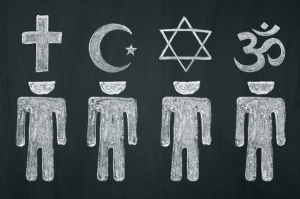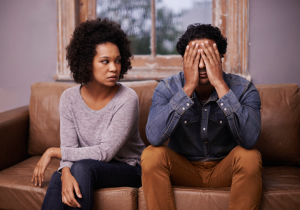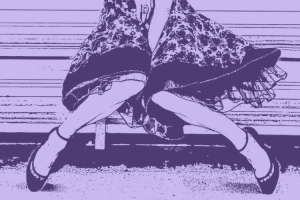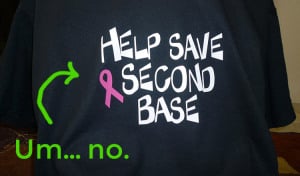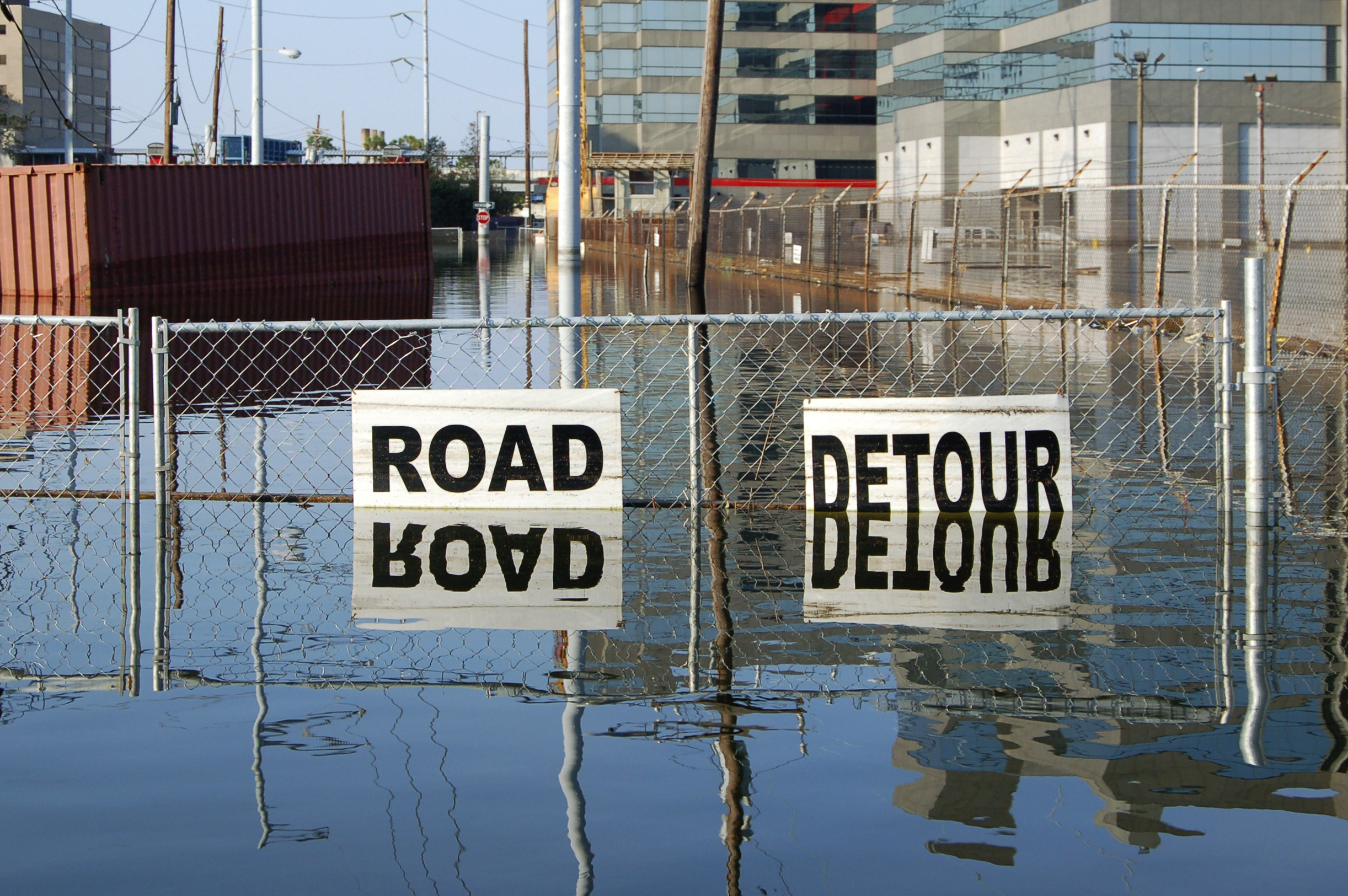
Flooded street with partially submerged signs that read “Road” and “Detour.”
Dr. Armen Henderson had seen her in the emergency room at least three times now. It was her second time calling an ambulance.
The waiting room at the University of Miami Hospital was crowded and full of people in need of medical attention after the devastation of Hurricane Irma. Henderson couldn’t understand why one of his patients kept coming back to hang in the chaos that is an emergency room.
When he inquired, she told him a dire situation.
For nearly two weeks, after surviving the destruction of the hurricane, herself and many of her neighbors were living in their cars in the parking lot of the Civic Towers Apartment Complex in Miami. Several residents were elderly and required medication.
The building had been badly damaged by the storm and the city considered it unsafe. They had no-where to go. And, though the city was able to place many of the residents in hotels, they may never be able to return.
Developers had been eyeing their neighborhood and other low-income Miami neighborhoods as the next “hot spot” to live. The storm would give them the perfect opportunity to swoop in for a land grab.
Those are the real-life circumstances for the low-income communities of color in the majority Latinx neighborhood Allapattah, located in Miami. It’s much worse for folks in Puerto Rico.
Most recently, Hurricanes Harvey, Irma, and Maria have devastated our southern coasts and the Caribbean. After surviving such devastation, residents have a new onslaught to look out for: climate gentrification.
Climate gentrification? What’s that?
Climate gentrification is when low-income and marginalized communities are displaced by factors related to climate change and sea-level rise — both environmental and manmade — said Miami activist Valencia Gunder.
The trend leads to an increase in property values, displacing longstanding residents, many of whom are often low-income communities and communities of color.
Climate-fueled gentrification is a real thing and we need to talk about how it’s regularly intensifying the harmful outcomes of gentrification. Here are three ways it does so:
1. Developers take advantage of displaced communities after natural disasters and purchase newly cheap land.
Though neighborhood investment can be great, gentrification isn’t. It almost always displaces disadvantaged residents and changes the overall culture of our neighborhoods.
Natural disasters, like hurricanes, have become more dangerous as a result of climate change and displaced over a million people in the United States in 2016. Poorer people and people of color are disproportionately affected.
After such devastation and loss, there’s generally a large push to rebuild. The only thing is, when a neighborhood is decimated and people are forced to leave, the land gets significantly cheaper.
Developers can take advantage of this and begin redeveloping the area. When not handled thoughtfully — which it often isn’t — it can make it very difficult for the original residents to come back.
Rebuilding jumpstarts gentrification, which in turn raises rents and makes the area more attractive to new higher income renters and homeowners.
This further displaces the previous residents, still reeling from the natural disaster, who can no longer afford to live or work in the newly built up neighborhood.
The city of New Orleans after Hurricane Katrina is one example of this. Along with killing thousands, the hurricane displaced over half of the city’s population, going from 484,674 before Katrina to 230,172 after. Many of those residents were never able to return to the city.
As neighborhoods recovered from the storm and began to build back, parts of the city also began to change and gentrify. Developers and new residents took advantage of the newly freed cheap real estate after the Hurricane.
“[After Katrina] they were saying they weren’t even going to rebuild this area,” longtime 9th Ward resident, Kim Ford, told The Guardian. “It was supposed to be grassland. Now to come with this – gentrification didn’t so much concern me, but the condos, that’s gentrification. It’s not being built for people like me.”
Houston, Texas is also currently facing a similar situation. Investors have begun to take advantage of Hurricane Harvey’s aftermath––vacant and destroyed homes––for the possibility of cheap flips.
2. Wealthier residents near the shoreline, in fear of sea level rise, move inland and further displace long-standing communities.
Through redlining, cities across the country have placed their minority and poorer population where they see fit.
In some cities — like Houston, TX, New Orleans, LA and Charleston, SC — low-income communities live in low-lying areas that are plagued by flooding and hit hardest by hurricanes.
But in other cities, the richer populations occupy the waterfront. With sea levels on the rise, due to climate change, they are now facing a dilemma.
Take Miami, Florida for example. The city has become the poster child for climate change due to the drastic predictions of rising sea levels. Parts of the waterfront are as much as 2 feet below sea level.
As climate change worsens, these once “hotspots” are now liabilities. Investors and homeowners living in these low lying areas, like beachfront properties, are now looking to move to higher ground — but people already live there.
The city’s highest elevations are home to much of the low-income communities and communities of color, like Little Haiti, where advocates are fighting displacement.
Liberty City native and Miami activist with The New Florida Majority, Valencia Gunder, is on the front-lines of that displacement.
“It’s happening in a way that’s almost invisible,” she said, at least to the mainstream public — it’s all too real for local residents. “People just have to learn how to identify what’s going on and be diligent about speaking out against it.”
Gunder has no plans to stop using her voice and platform to educate and uplift those voices.
3. A push for climate change sustainability is making communities more appealing to newcomers, aiding gentrification.
City planners, developers and activists alike have been making a push for environmental improvements to their communities to better prepare for climate change, improve sustainability and overall beautification.
These changes and enhancements make communities more appealing and attractive to new residents which, when not handled thoughtfully, can often lead to gentrification.
This circumstance is also called Environmental Gentrification, since it can be caused by preventative climate change action, among other things.
Improvements — like bike lanes and added green spaces — have become leading selling points for developers.
Activists and community residents spend years fighting for these changes. But their success feels insignificant when it leads to gentrification.
“It’s pretty upsetting and confusing,” said filmmaker Susie Smith, who documented similar changes in San Francisco in her film People Live Here. “You want people to get involved in their communities. They get involved, they fight and they win and then they’re like ‘Oh shit.’”
After pushing for environmental betterment, it can be frustrating when those improvements in-turn led to gentrification and the original community doesn’t reap the benefits.
The focus on combatting climate change through sustainable improvements can lead to gentrification.
The Highline in New York City’s Chelsea neighborhood is another example. In a push for environmental sustainability in the fight against climate change, what was once an old and unused elevated railway was turned into a park.
And though beautiful, extremely popular and highly sustainable, the park’s creators admittedly took little-to-no consideration of the parks potential effects on the surrounding community. It led to rampant gentrification and rent spikes, displacing and changing much of the neighborhood.
***
Climate change may be unavoidable at this point, but gentrification is, most definitely, preventable. How we respond to the effects of climate change has lasting implications.
The Trump administration is working tirelessly to dismantle the few safeguards in place to lessen the impacts of climate change, such as repealing the Clean Power Plan and withdrawing the U.S. from the Paris Climate Accord.
If we handle the impacts of climate change carelessly, current problems, like gentrification, will only be exasperated.
Climate change has the power to end — or drastically alter — human life in the not-so-far future. And, while it’s easy to become numb to the threats of climate change, they are more than threats — they’re promises.
This summer alone has felt like an unending slew of natural disasters, not just in the U.S. but globally.
But there is still time to make changes.
It will take thoughtful recovery and aid tactics in communities of color after disasters, said Threads of Solidarity: WOC Against Racism. It takes the support of our local on-the-ground organizations that take on these and other issues daily.
Whether it’s sustainability improvements, redevelopment after a natural disaster or any major change in our communities — climate change related or not — we must be honestly aware of who benefits from it: Re-developed, for whom? Improved, for whom? Sustainable, for whom?
So, what can you do?
Start by educating yourself on the climate issues affecting your community.
“Get active. Get involved. Use your voice and your vote,” said Gunder. “We have to stay steadfast in our fight, as we know that this is just one of many battles in the war. We have to show up for it.”
[do_widget id=’text-101′]
Maya Lewis is an Everyday Feminism Reporting Fellow. Maya is a 20-something Brooklynite, by way of Maryland. She spends her time writing about things she believes are interesting and finding ways to trick people into reading them.
Search our 3000+ articles!
Read our articles about:
Our online racial justice training
Used by hundreds of universities, non-profits, and businesses.
Click to learn more
Most Read Articles
- « Previous
- 1
- …
- 30
- 31
- 32






